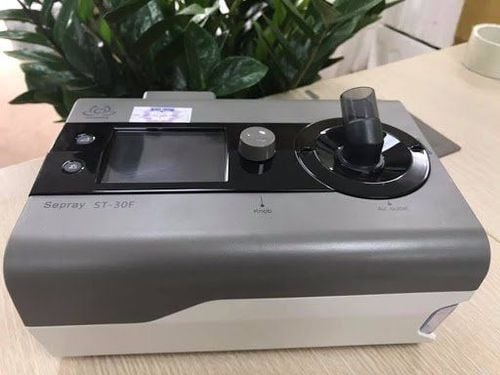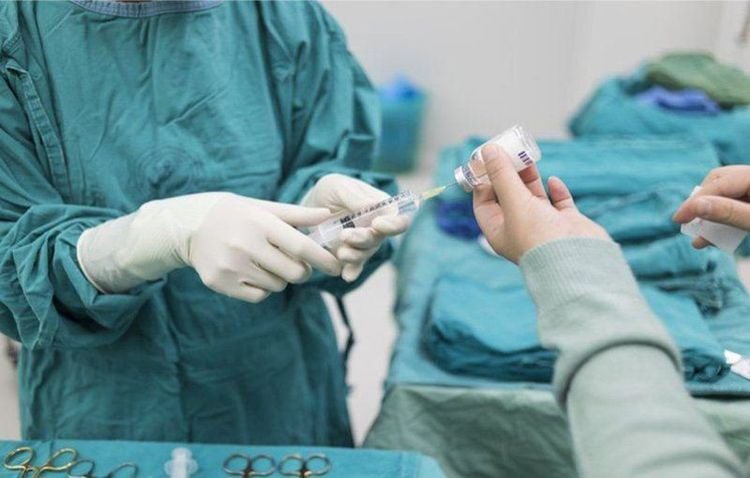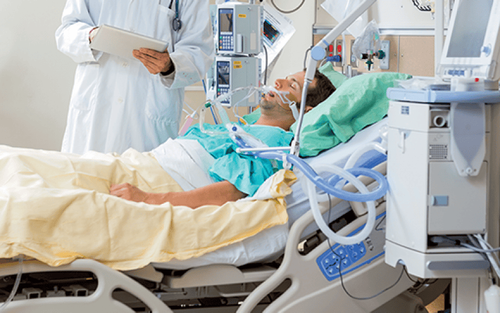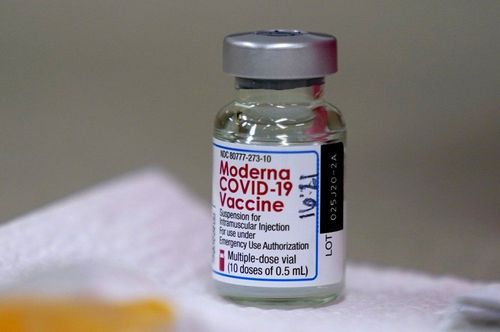This is an automatically translated article.
New strain of corona virus causes a global pandemic of respiratory infections COVID-19. This virus called SARS-CoV-2 enters the respiratory tract, making it difficult for patients to breathe, respiratory failure. A 2-way ventilator is a device that helps a patient breathe when unable to do it on their own.
1. What is a ventilator?
It is estimated that so far about 6% of people with COVID-19 have developed severe disease, and about a quarter of these people need to use a 2-way ventilator to perform respiratory function. These figures continue to change rapidly as the COVID-19 epidemic continues to spread globally.
Using an oxygen ventilator , or intubation is the procedure indicated when the patient cannot breathe on his own. Your doctor will place a tube down your throat and into your windpipe to make it easier for air to get in and out of your lungs. The ventilator pumps air with extra oxygen, helping the patient breathe and remove carbon dioxide (CO2). Mechanical ventilation works to keep the patient's oxygen and CO2 levels stable.
Doctors also often refer to this device as a mechanical ventilator. Unlike a respirator, which is a device exclusively worn by healthcare workers when caring for someone with an infectious disease, a ventilator is an electrical device usually placed at the head of the bed, with tubes connected to the patient's airway. core.
2. How does a ventilator work?

Hình ảnh máy trợ thở 2 chiều
2.1. In a patient with COVID-19 When a patient's lungs normally inhale and exhale air, the cells take in the oxygen they need to survive and remove carbon dioxide. But the respiratory disease COVID-19 will "submerge" the patient's lungs in liquid, causing them to suffocate.
Accordingly, a 2-way ventilator helps to pump oxygen into the body. Air passes through a tube, into the mouth, and down the windpipe. The machine can also assist with exhalation, or the patient will do it himself if possible.
The ventilator is set by the doctor to perform a certain number of breaths per minute, or automatically activates only when the patient really needs breathing assistance. In this case, the machine will automatically blow air into the lungs if the patient is not breathing for a certain period of time.
2.2. Intubation Cases General anesthetics used during surgery can also make it difficult for the patient to breathe. Intubation allows an external electrical device to do the job of breathing for the patient. This is why anesthesiologists often use oxygen ventilators and intubate people preparing for surgery.
Ventilators can also be used if the patient has an injury or is having trouble breathing. Breathing provides the oxygen that every cell in the body needs. Without enough O2, the patient will experience unconsciousness, brain damage and even death. The machine also supports the exhalation direction, helping to remove CO2. If CO2 builds up in the blood, it will cause respiratory acidosis and lead to other health problems.
There are cases, even when the patient is breathing normally and the oxygen level in the blood is stable, the doctor still prescribes intubation because the patient is unconscious. A serious illness or injury can cause the patient's ability to breathe quickly to worsen, or impair the reflexes in the patient's airway.
The doctor also prescribes the use of an oxygen ventilator and intubation if the patient needs urgent surgery that requires general anesthesia. In this case, the patient needs to fast to empty the stomach. Food from the stomach can back up or enter the lungs if the patient vomits. To prevent this from happening, an inflated air tube will be installed to seal the airway from the patient's stomach.
3. Ventilator placement procedure

Bệnh nhân thường sử dụng thuốc an thần trước khi đặt ống vào
Two-way ventilators do not cure COVID-19 or other illnesses that cause problems in the patient's respiratory tract. This device only helps the patient to survive the crisis, until the patient is better and the lungs can function on their own.
Except in rare cases, doctors usually give the patient a sedation or general anesthetic before the tube is inserted. A medication that paralyzes the airways is also used to avoid the body's reflexes when something is pressed against it, such as gagging or struggling.
The patient can be given some oxygen from the mask for 2 - 3 minutes before the procedure begins to increase the O2 level in the blood. The patient lies supine with the head tilted slightly backward. The doctor inserts a catheter with a light and camera into the patient's mouth to view the airways through a video monitor.
Then, the doctor will thread the tube between the vocal cords and down the patient's windpipe, connecting part of the airway to the lungs. Once the tube is in place, the doctor inflates the tube to seal off most of the airway from the stomach, to keep food from backing up into the lungs but still allowing air to get through.
If there are no problems, the process should not take more than 5 minutes. The doctor may need to check the patient's breathing through a stethoscope, monitor CO2 levels, or take a chest X-ray.
When the patient is fine, the doctor will conduct an assessment of the patient's breathing. The oxygen ventilator is still connected but will adjust the setting so that the patient tries to breathe on their own. When the patient is able to breathe normally, the doctor will remove the breathing tubes and turn off the ventilator.
4. Complications of oxygen ventilator and intubation

Đặt nội khí quản có thể dẫn đến biến chứng đau họng cho bệnh nhân
Intubation very rarely causes complications, but there are cases of problems. Side effects include damaging the patient's teeth or creating a wound in the mouth. The breathing tube also affects the throat and voice box, so the patient may have a sore throat or difficulty talking and breathing for a while. The intubation procedure carries the risk of damaging your lungs or leading to an infection or pneumonia.
The breathing tube placed in the throat causes many inconveniences, making the patient unable to eat or talk. Some people on a 2-way ventilator will not be able to eat and drink normally, and will need to get nutrients through an IV line.
Intubation, using a ventilator is a routine technique at Vinmec International General Hospital. Accordingly, Vinmec has also applied the intubation technique to examine, diagnose, treat, and provide emergency treatment for many different diseases.
The technique of placing ventilators at Vinmec is performed methodically and according to the standards of the procedure by a team of highly qualified medical professionals with modern and standard machinery systems, so complications can be minimized when used. and after weaning off the ventilator.
If there is a need for consultation and examination at the Hospitals of the National Health System, please book an appointment on the website to be served.
Please dial HOTLINE for more information or register for an appointment HERE. Download MyVinmec app to make appointments faster and to manage your bookings easily.













